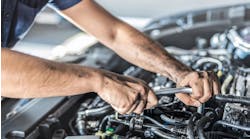A lifetime ago, I was piloting an aircraft cross country on the "red eye” from California to Charlotte, North Carolina. On clear moonlit nights with visibility for hundreds of miles in each direction, we’d ask Air Traffic Control if we could proceed “TLAR (pronounced tee-larr) Direct.” We’d turn the illumination down on the instruments until they were just barely lit, and we’d navigate by reference to the proximity of the cities whose lights were visible from many miles away. Although not precise, it got us close because we could cross reference our position visually and with our navigation equipment if we wanted to.
TLAR is an acronym for That Looks About Right (not an official FAA-approved term), and my experience mentoring young shop owners seems to reflect this same methodology regarding labor pricing. They come up with a figure “that looks about right,” but unlike flying, which had defined points of reference to ensure we were heading in the right direction and remained on the right track, their figures are arbitrary and are frequently based on what neighboring shops are charging. The great automotive writer Mitch Schneider used to call this the “Oreo effect.” One shop lower in price, one shop higher and they would be in the middle to “remain competitive.”
This pricing strategy is fraught with problems and is usually spawned from (a) lack of sufficient operating capital, (b) fear of failure caused by being perceived as “charging too much,” (c) a lack of knowledge of what methods to use to determine how much to charge, and (d) a reluctance to use math.
There are several methods to use to determine your posted shop labor rate. Some methods directly contradict one another and that’s OK; you need to find out what works for you. The key, however, is knowing that your labor rate must be based on your expenses, not the shop up the street and most certainly not what everyone else is charging.
One method often used by shops familiar with their key performance indicators (KPI) depends on knowing your shop’s total fixed monthly expenses divided by its gross profit margin expressed as a percentage. This will yield your break-even number. Based on your break-even number, desired profit and hours available for work, some calculations are made, and the result is the shop’s labor rate based on its record of labor hours sold over a specific time. Obviously, this works well for established shop owners who have a record available to them, but a new shop owner will need a place to begin. For the benefit of new shop owners who may be unfamiliar with key performance indicators, these are internal tracking or reference points that provide information to keep your business on course. Just as I referenced the instruments and the lights of the cities in the distance while piloting the “red eye,” every successful business relies on knowing where it is at any given point in time.
Another more basic method to establish a labor rate target entails knowing all your technicians' expenses (total of wage and benefits) and establishing the shop labor rate on a 70% gross profit margin. So, if a technician costs you $30 per hour, your beginning target rate would be $100 per hour. This is a good starting point for the new shop owner. A 70% gross profit margin on labor combined with a minimum of 50% gross profit margin on parts (excluding tires) yields a 60% gross profit margin for the business. Here’s where the new shop owner must pay careful attention to billed labor hours produced by the technician, as well as shop overhead.
By tracking the hours consistently billed by a technician per day, per week, per month the labor rate can be modified to ensure that it pays for all the overhead as well as the desired profit. The important thing to remember is that just as an aircraft requires frequent control inputs to keep it on course, the labor rate also requires attention and fine tuning as well.



